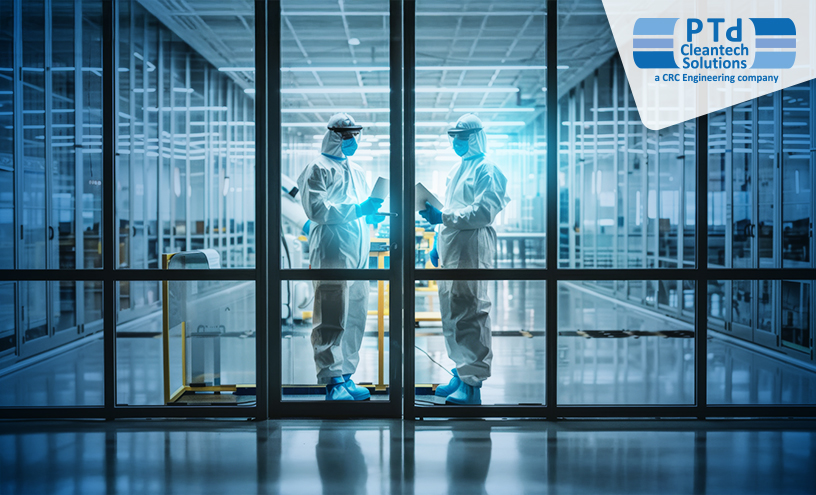Cleanrooms are extremely regulated spaces with precise humidity and air quality controls. They are crucial to sectors like biotechnology, electronics manufacturing, and pharmaceuticals. Organisations are increasingly considering retrofitting existing facilities instead of starting from scratch. This strategy helps companies to take advantage of their current infrastructure and shorten lead times. Meticulous preparation and execution are needed though, to meet the compliance standards.
The first and foremost step in the process is to evaluate the facility’s current condition. The appropriateness of each structural component and service line must be assessed. Like air handling systems in older industrial buildings might not be able to satisfy the pressurisation and filtration standards of a cleanroom that complies with regulations. It may be necessary to replace or line existing walls and ceilings with materials that reduce particle shedding. To make sure they can meet the cleanroom’s operational requirements without posing a risk of contamination, the plumbing and electrical systems should also be examined.
Planning for Compliance from the Start
It is crucial to approach retrofitting as though you were creating a brand-new cleanroom from the ground up. This entails abiding by any sector-specific laws as well as international standards like ISO 14644. All design choices will be in line with compliance requirements if architects and cleanroom specialists are consulted early on. The design should avoid cross-contamination and encourage an effective workflow. To clearly distinguish between clean and unclean areas, material and personnel flows must be mapped.
HVAC systems should be designed to maintain the necessary pressure differentials between areas of varying cleanliness grades and to supply the appropriate air changes per hour. Selecting finishes that are easy to clean, smooth, and non-porous is equally crucial. At this point, modular construction methods may also be taken into consideration. Prefabricated parts and modular panels can at times expedite installation and simplify subsequent upgrades. These components are mostly used in the semiconductor facility design, where maintenance-ease ends up to be a very crucial process.
Integrating Key Systems into the Retrofit
The smooth integration of mechanical and electrical control systems is essential to a compliant cleanroom. It might end up to be difficult to retrofit an existing building, particularly if there is limited space or if these systems were not considered when the original structure was designed. HVAC systems frequently need to be completely upgraded or replaced. This entails setting up control systems and high-efficiency particulate air (HEPA) and ultra-low particulate air (ULPA) filters that can maintain exact environmental conditions.
Lighting should be planned to minimise heat production and prevent disruptions to airflow. Due to their low particulate emissions and energy efficiency, LED fixtures are frequently chosen. Electrical systems must be strong enough to support specialised equipment without producing voltage swings or electromagnetic interference. This degree of accuracy is essential to guaranteeing production quality in semiconductor facility design.
It is also crucial to have efficient monitoring and control systems in place. Temperature, humidity, particle counts, pressure differentials, etc., should all be continuously measured by these, and when conditions deviate from the parameters, alarms should be aired. Prompt adjustments that can be made without human intervention help automation increase reliability.
Managing Costs and Timelines
Cost effectiveness is yet another primary justification for retrofitting. Using an existing structure, significant civil works and new land acquisition are avoided. Retrofitting still requires a large financial outlay, though, and expenses can rise if not planned for. It is extremely important to have a thorough project plan with backup plans. Finding cost-saving options, like reusing structural components or putting in modular cleanroom units that can be used again in other projects, can be facilitated by consulting with experts in semiconductor facility design.
Timelines are yet another important factor. In order to prevent contamination and production delays, retrofitting work may need to be planned around ongoing operations. Disruptions can be minimised by using phased construction, in which one section is finished and approved before going on to the next. The facility must go through a thorough validation process after the retrofit is finished. This demonstrates compliance. This entails the evaluation of how well the cleanroom performs in terms of airflow and contamination control under operational circumstances. The cleanroom can only be approved for use following a successful validation.
Although converting an existing facility into a compliant cleanroom is a challenging task, it is possible to produce a high-quality and reasonably priced solution with the correct preparation and project management. A retrofit can prolong the life of current assets while satisfying the strictest industry standards, whether for pharmaceutical, biotechnology, or semiconductor facility design.

